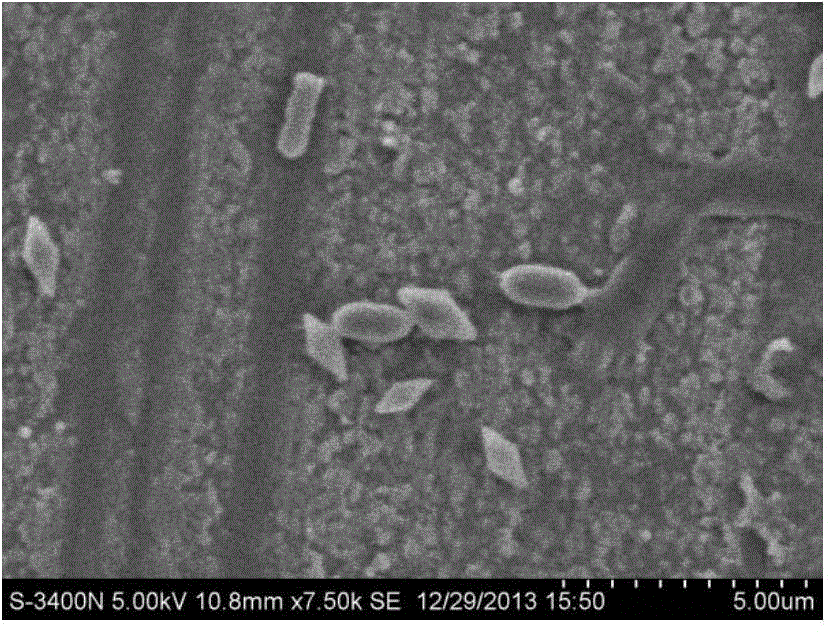Bacillus thuringiensis FH21, insecticide gene, expression protein and application thereof
A technology of Bacillus thuringiensis and FH21, applied in the fields of application, insecticide, genetic engineering, etc., can solve the problems of single pests and increased resistance of pests, achieve broad application prospects, expand insecticidal spectrum, and delay drug resistance.
- Summary
- Abstract
- Description
- Claims
- Application Information
AI Technical Summary
Problems solved by technology
Method used
Image
Examples
Embodiment 1
[0053] Embodiment 1, isolate Bacillus thuringiensis bacterial strain FH21
[0054] The applicant's laboratory staff obtained a strain of Bacillus thuringiensis isolated from the soil of Fenghuang Mountain in Heilongjiang Province. The spores of Bacillus thuringiensis are spore outer wall, spore coat, cortex, spore inner wall, protoplasmic membrane and protoplast from outside to inside. . The main component of the cortex is peptidoglycan, a polysaccharide teichoic acid that does not contain vegetative cells, which maintains the dehydration state and heat resistance of the spores. On the other hand, during the formation of the spores, a large amount of DPA-Ca will be produced. thuringiensis spores will not die after heat treatment at 80°C for 20 minutes, and the dormant spores are treated at a sub-lethal temperature of 75°C for 15 minutes, the activation effect is the best , not only promote its rapid germination, but also improve the survival rate of spores (Yu Ziniu 1990). B...
Embodiment 2
[0071] Example 2. Obtaining new genes
[0072] 21 Use cry gene universal primers to detect strain FH21, the primers are as follows
[0073]
[0074]
[0075] Amplification cycle: denaturation at 94°C for 1 minute, annealing at 56°C for 1 minute, extension at 72°C for 4 minutes, 25 cycles, and finally extension at 72°C for 10 minutes.
[0076] The result is as image 3 As shown, strain FH21 was subjected to genotype PCR identification, and PCR products of different sizes were obtained by using cry1 gene identification primers.
[0077] 2.2 A rapid cloning method was used to isolate and clone the new sip1A gene in the strain.
[0078] Using pfuDNA polymerase, PCR amplification was performed with the following system.
[0079]
[0080]
[0081] Make up to 50 μL with ultrapure water, mix well and centrifuge.
[0082] Amplification cycle: denaturation at 94°C for 1 minute, annealing at 54°C for 1 minute, extension at 72°C for 1 minute, 25 cycles, and finally extensi...
Embodiment 3
[0099] Embodiment 3, gene expression and activity assay
[0100] 3.1.1 Plasmid DNA was extracted from the above clones, and transformed into the recipient strain Rosetta (DE3) to obtain an expression strain.
[0101] After IPTG induced expression, SDS-PAGE protein electrophoresis was performed. The process of inducing expression is as follows:
[0102] 1) Activated strains (37°C, 12hr);
[0103] 2) 10% inoculated in LB medium (37°C, 2hr);
[0104] 3) Add the inducer IPTG, 150rpm, and induce at 18-22°C for 4-20h at low temperature;
[0105] 4) The cells were collected by centrifugation, and 10 mM Tris Cl (pH 8.0) was added to suspend;
[0106] 5) Broken bacteria (ultrasonic crushing is complete);
[0107] Centrifuge at 12,000rpm for 10min at 4°C;
[0108] Collect 10-15 μL each of the supernatant and the precipitate, and detect them by electrophoresis.
[0109] The polyacrylamide gel configuration is as follows.
[0110]
[0111] Sample loading: 10-15μl sample loading...
PUM
 Login to View More
Login to View More Abstract
Description
Claims
Application Information
 Login to View More
Login to View More - R&D Engineer
- R&D Manager
- IP Professional
- Industry Leading Data Capabilities
- Powerful AI technology
- Patent DNA Extraction
Browse by: Latest US Patents, China's latest patents, Technical Efficacy Thesaurus, Application Domain, Technology Topic, Popular Technical Reports.
© 2024 PatSnap. All rights reserved.Legal|Privacy policy|Modern Slavery Act Transparency Statement|Sitemap|About US| Contact US: help@patsnap.com










